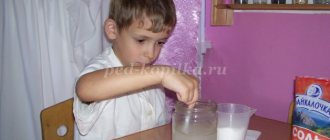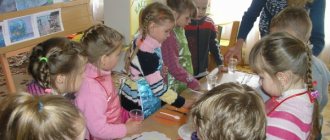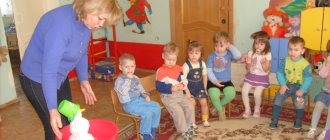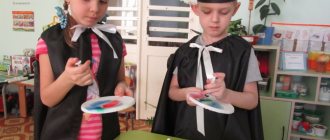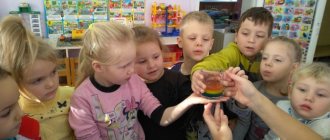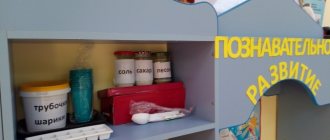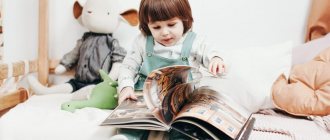Experimental activities of preschool children
Introduction
In accordance with the Federal Law “On Education in the Russian Federation,” preschool education in Russia has acquired the status of the first level of general education. Relations in the field of preschool education in the implementation of educational programs are now regulated on the basis of the Federal State Educational Standard for Preschool Education.
The federal state educational standard is aimed at solving many problems. One of them is “the creation of favorable conditions for the cognitive development of children in accordance with their age and individual characteristics and inclinations, the development of the abilities and creative potential of each child as a subject of relationships with himself, other children, adults and the world...” (hereinafter referred to as the Federal State Educational Standard for Education). (Federal State Educational Standard 1.6) [8].
Currently, the latest developments, technologies, and methods are being formed and successfully applied in the preschool education system, which make it possible to raise the level of preschool education to a higher and higher quality level. One of such effective methods of understanding the patterns and phenomena of the surrounding world is experimental activity.
It is known that familiarization with any subject or phenomenon gives the most optimal result if it is effective. One such activity is experimentation. The works of many domestic teachers (N.N. Poddyakova, A.P. Usova, E.L. Panko) say that children's experimentation claims to be the leading activity in the period of preschool development, and highlight the main feature of this cognitive activity: the child learns an object in the course of practical activities with it, the practical actions carried out by the child perform a cognitive, orientation and research function, creating conditions in which the content of this object is revealed.
It is experimental activity that helps a preschool educational institution graduate meet the requirements of the Federal State Educational Standard, according to which a graduate today must have such qualities as curiosity, activity, which encourage interest in the new, unknown in the world around him. In the course of experimental activities, the preschooler learns to observe, think, compare, answer questions, draw conclusions, establish a cause-and-effect relationship, and follow safety rules.
Specially organized experimental activities allow students to obtain information about the phenomena or objects being studied, and the teacher to make the learning process as effective as possible and more fully satisfy the natural curiosity of preschoolers.
The purpose of the study is to study the features of the organization of experimental activities of preschool children.
The object of the study is the educational activities of preschool children.
The subject of the study is the features of experimental activities in preschool educational institutions.
Research objectives:
- consider the concepts of experiment and experience;
— study the features of organizing experimental activities in accordance with the age of preschool children;
— to identify the conditions for organizing experimental work in preschool educational institutions.
The practical significance of the work lies in the fact that methodological materials can be used in the work of teachers of preschool educational institutions.
Definition of the concept of “experiment”, “experience”
Currently, we are witnessing how another effective method of understanding the patterns and phenomena of the surrounding world is being formed in the preschool education system - the method of experimentation.
The word “experiment” comes from Greek and is translated as “test, experience.”
The “Modern Dictionary of Foreign Words” contains the following definition[6]: An experiment is:
— “scientifically staged experiment, observation of the phenomenon being studied under scientifically taken into account conditions, allowing one to monitor the progress of the phenomenon and reproduce it many times when these conditions are repeated”;
- “generally an experience, an attempt to accomplish something.”
“An experiment... is a systematic observation. Thus, a person creates the possibility of observations, on the basis of which his knowledge about the patterns in the observed phenomenon is formed” [3, p. 459].
“Experiment... sensory-objective activity in science; in a narrower sense of the word - experience, reproduction of the object of knowledge, testing of hypotheses, etc.” [5, p. 1034].
From the above definitions it is clear that in the narrow sense of the word the terms “experience” and “experiment” are synonymous: the concept of experience essentially coincides with the category of practice, in particular, experiment and observation.
So, like most words in the Russian language, “experimentation” is a polysemantic word. It acts as a teaching method if it is used to transfer new knowledge to children. It can be considered as a form of organizing the pedagogical process if it is based on the method of experimentation. And finally, experimentation is one of the types of cognitive activity of children and adults, as can be seen from the definitions given above.
Experimental activities of preschoolers in accordance with age characteristics
Summarizing his own rich factual material, N.N. Poddyakov formulated the hypothesis that in childhood the leading activity is not play, as is commonly believed, but experimentation [4].
To substantiate this conclusion, he provides evidence.
1. Play activities require stimulation and a certain organization on the part of adults; the game must be taught. In the activity of experimentation, the child independently influences the objects and phenomena around him in various ways (including other people) in order to more fully understand them. This activity is not assigned to an adult child, but is constructed by the children themselves.
2. In experimentation, the moment of self-development is quite clearly presented: the transformations of an object carried out by a child reveal new aspects and properties of the object to him, and new knowledge about the object, in turn, allows him to make new, more complex and perfect transformations.
3. Some children don't like to play; they prefer to do something; but their mental development proceeds normally. When deprived of the opportunity to get acquainted with the world around him through experimentation, the child’s mental development is inhibited.
4. Finally, fundamental evidence is the fact that the activity of experimentation permeates all areas of children's life, including play. The latter arises much later than the activity of experimentation.
Thus, it is impossible to deny the validity of the statement that experiments form the basis of all knowledge, that without them any concepts turn into dry abstractions. In preschool education, experimentation is a teaching method that allows a child to model in his creation a picture of the world based on his own observations, experiences, establishing interdependencies, patterns, etc.
Since interest in experimentation arises from an early age, classes on children’s experimentation in kindergarten begin with the 2nd junior group.
With the help of game characters, children are presented with the simplest problem situations: Will a paper boat sink? How to hide a ring in water from a fox? Why can't you eat snow? How to walk on ice without falling, etc.
In the second younger group, children master the actions of transfusion, pouring various materials and substances. Get acquainted with the properties of some materials and inanimate objects: water, ice, snow. They learn about light sources, that if you shine light on an object, a shadow will appear, that different objects and animals make different sounds, etc.
In the 5th - 6th year of life, children continue to enrich their experience in understanding the world around them. At this stage, children begin to practically master the properties and qualities of various materials, children actively participate in the study and transformation of various problem situations, and become familiar with ways to record the results obtained. Experiments are conducted with children to identify the causes of individual phenomena, for example, “Why did this handkerchief dry faster?” (because it was on battery); “Whose house is stronger: what materials did the wind blow away the house from and why.” Children learn to compare the properties of sand and clay, learn and expand their understanding of the properties of water and air, their meaning, the types and properties of fabrics, and learn about the properties of a magnet and a magnifying glass.
During joint experimentation, it is necessary to set a goal, put forward hypotheses, jointly determine the stages of work, and draw conclusions.
In the process of experimentation, children often receive completely unexpected information, which leads to significant restructuring and change in their activities. This demonstrates the flexibility of children's experimentation - the ability to rearrange their activities depending on the results obtained. The organization of experimentation work is carried out in three interrelated areas [1]:
— living nature (characteristic features of seasons in different climatic zones, diversity of animal organisms, their adaptation to the environment, etc.);
- inanimate nature (air, water, soil, electricity, sound, weight, light, color, etc.);
— man (functioning of the body, man-made world, transformation of objects, etc.).
In the process of experimentation, children acquire interpersonal communication and cooperation skills: the ability to negotiate, defend their opinions, and reason in dialogue with other children. To do this, when discussing problematic situations, you need to draw children’s attention to the opinions of others, teach them to listen to each other, and invite more active children to help shy ones.
Also teach children to ask questions during activities, highlight the sequence of actions, reflect them in speech when answering questions like: what did we do? what did we get? Why?
After each experiment, children should be taught to be independent when cleaning the workplace.
In the 6th and 7th years of life, children’s ideas about the world around them become increasingly deeper, and experiments become more complex in content and methodology.
Now the initiative to conduct experiments more often belongs to children. The tasks of predicting results are gradually increasing. For example, “Today we planted oat grains, think about what it will be like in 10 days.”
It is necessary to encourage children to independently analyze the results of experiments, the desire to draw conclusions, and compose a detailed story about what they saw. Experimentation can be organized in the following forms: joint (partnership) activity of the teacher and students, independent activity of children.
Conditions for organizing experimental activities in preschool educational institutions
The organization of experimentation in a preschool educational institution presupposes the fulfillment of certain psychological and pedagogical conditions that contribute to the achievement of positive results. These conditions include three main components: content, subject-development environment and psychological comfort. Let's take a closer look.
Speaking about the content of organizing experimental activities for children, it is advisable to note the need to create a file cabinet of experiments and experiments.
The role of the card index can hardly be overestimated, since this material is the main assistant to the teacher in preparing and organizing children's activities, because each of the cards reflects information about the purpose and objectives of the experiment, its content, equipment that is necessary for the experiment and a fixed expected result. In addition, the card index principle allows you to systematize the available materials depending on the age of the children, topics and program content. Moreover, the system of developed forms of experimental activity does not contradict, but, on the contrary, is an integral part of complex thematic planning of the entire educational process.
The second condition for solving problems in experimental activities in kindergarten is the organization of a developmental environment. The main requirements for the environment as a developmental tool are to ensure the development of active independent children's activities. Therefore, when equipping and organizing a space for experimental activities of preschoolers, it is necessary to zone it thoughtfully and productively.
In the experimental activity corner (mini-laboratory) the following should be highlighted [2]:
1. A place for a permanent exhibition, where a mini museum is located, which can house various collections. Exhibits, rare items (shells, stones, crystals, feathers, etc.)
2. Place for devices. The main equipment in the corner are assistant devices, such as: microscopes, magnifying glasses, compass, scales, hourglasses, magnets. Technical materials: nuts, paper clips, bolts, nails . Food and non-food dyes (gouache, watercolor paints. Medical materials: pipettes, flasks, wooden sticks, syringes (without needles), measuring spoons, rubber bulbs and other materials.
3. A place to store natural and “waste” materials (pebbles, shells, pine cones, feathers, moss, leaves, etc.; wire, pieces of leather, fur, fabric, plastic, cork).
4. The testing area must be sufficient and unobstructed to accommodate a minimum of 2 people. It is better that this place can be mobile to provide visibility from all sides when demonstrating the experiment.
5. Place for unstructured materials (sand, water, sawdust, shavings, foam plastic, etc.) Materials in this zone are distributed in the following areas: “Sand and water”, “Sound”, “Magnets”, “Paper”, “Light”, “Glass and plastic.
The material for conducting experiments in the experimentation corner changes in accordance with the work plan.
To support interest in experimentation, some problem situations are formulated on behalf of the fairy-tale hero.
So, for example, a Wise Dwarf can live in the laboratory, on whose behalf tasks - notes - are offered. For example, one day the children found an envelope with bean and pea seeds and a note: “Explain what appears at the beginning: the root or the stem?”
In the process of experimentation, children form not only intellectual impressions, but also develop the ability to work in a team and independently, defend their own point of view, prove its correctness, determine the reasons for the failure of experimental activities, and draw basic conclusions. A competent combination of materials and equipment in the corner experimentation contributes to children’s mastery of the means of cognitive activity, methods of action, examination of objects, and expansion of cognitive experience.
And lastly, it is known that not a single educational or educational task can be successfully solved without fruitful contact with the family and complete mutual understanding between parents and teacher. In individual conversations, consultations, and at parent meetings through various types of visual agitation, we convince parents of the need for daily attention to children’s joys and sorrows, encouraging the child’s desire to learn new things, independently find out what is incomprehensible, and understand the essence of objects and phenomena.
Conclusion
Children's experimentation is a special form of search activity in which the processes of goal formation, the processes of the emergence and development of new personal motives that underlie the self-movement and self-development of preschool children are most clearly expressed.
The use of experimental activities in pedagogical practice is effective and necessary for the development of preschoolers' research activities, cognitive interest, increasing the amount of knowledge and the ability to master this knowledge.
Since experimental activities provide a preschooler with the opportunity to directly satisfy his inherent curiosity and streamline his ideas about the world.
Thanks to cognitive interest, both knowledge itself and the process of acquiring it can become a driving force in the development of intelligence and an important factor in the education of the individual.
Thus, the experimentation method allows children to implement the self-development program inherent in them and satisfy the need for cognition in an effective and accessible way for them - through independent exploration of the world. Cognitive interests have a great motivating influence on the process and result of learning.
This allows preschoolers to fully form the prerequisites for educational activities at the stage of completing their preschool education.
Literature.
1. Derevova S.N. Experimental activities of older preschoolers in accordance with the requirements of the Federal State Educational Standard of Preschool Educational Institution / Website “Academy of Preschool Education” (https://www.adou.ru/categories/2/articles/160)
2. Dorokhova T.M. Organization and conduct of experimental activities with preschoolers / All-Russian electronic journal “Preschool Education Teacher” (https://www.pdou.ru/categories/2/articles/2028)
3. Brief philosophical encyclopedia. - M.: Progress, 1994. - 576 p.
4. Poddyakov, A.N. Development of research initiative in childhood: Author's abstract. dis. ... doc. Psych.Sc. –M., 2001.
5. Soviet encyclopedic dictionary. ed. A. M. Prokhorov. M. Soviet Encyclopedia. 1987.
6. Modern dictionary of foreign words. - M.: AST-PRESS KNIGA, 2012.
7. Chemodanova M.V. Experimental activities as a means of cognitive development of older preschoolers // Collection of materials of the Annual International Scientific and Practical Conference “Education and Education of Young Children”. - 2016. - No. 5. — P.970-972.
8. Federal State Educational Standard for Preschool Education [Electronic resource]: Access mode - https://www.firo.ru/wp-content/uploads/2013/11/PR_1155.pdf (access date 09/25/2016).
Organization of experimental activities in preschool educational institutions
Bibliographic description:
Chernenko, M. A. Organization of experimental activities in preschool educational institutions / M. A. Chernenko. — Text: direct // Questions of preschool pedagogy. — 2022. — No. 3 (13). — P. 95-98. — URL: https://moluch.ru/th/1/archive/92/3332/ (access date: 01/18/2022).
Preschoolers are natural explorers. And this is confirmed by their curiosity and continuous desire to experiment, the desire to always find a solution in the presence of a problem situation. Information about the world around us is absorbed more firmly and for a long time when the child sees, hears and does everything independently.
To explore, to discover, to study—this involves taking a step into what is unknown. “At one time, I.M. Sechenov wrote about the innate and “extremely precious” characteristic of the neuropsychic organization of children - an unconscious desire to understand the life around them.
Currently, the question is about improving the quality of upbringing and education of the younger generation at all levels of the educational system of our country. A special type of pedagogical work, covering all aspects of activity, is experimentation. Children's experimentation is a complex, multifaceted process that includes both live observation and experiments conducted by the child. During its course, the preschooler gradually masters the model of research activity - from posing a problem to putting forward a hypothesis and testing it experimentally.
The world of children is a wonderful world - a world of whys. Our children are very active and inquisitive. They always have many questions that they immediately want answered. So that children can independently find answers to all their questions, we began research activities on inanimate nature at the preschool educational institution: “Young Researchers”. Teachers try to draw the children’s attention to the fact that even familiar objects: water, sun, air, sand contain quite a lot of unknowns. Despite their rather early age, children need to be taught the skills of environmentally literate attitudes in nature, in everyday life, and in everyday life.
In the educational process of a preschool institution, children's experimentation allows the child to model in his mind a picture of the world based on his own observations and experiences, and to establish relationships and patterns. Experimental activities arouse the child's interest in exploring nature, develop mental operations (analysis, synthesis, classification, generalization), stimulate cognitive activity and curiosity.
By organizing work on experimental activities, we provide for the inclusion of preschoolers in meaningful activities, during which they themselves could discover more and more new properties of objects, notice their similarities and differences.
In a word, children are given the opportunity to acquire knowledge independently in accordance with the federal state educational standard for preschool education.
We strive to see students as sociable, inquisitive, creative, independent individuals who know how to navigate their surroundings and successfully solve emerging problems, which largely depends on us. All researchers of experimentation highlight the main characteristic feature of the cognitive activity of children: the child learns an object in the process of practical work with it, the practical actions performed by the child have a cognitive, indicative and research function, forming the conditions in which the content of a particular object is revealed.
The relevance of the chosen experience is that in the conditions of a modern preschool institution, one of the significant tasks is the optimization of pedagogical work aimed at developing creative initiative and independence in the process of experimentation.
The main goal of the preschool educational institution: the development of cognitive interests, needs and independent search activities on the basis of enriched and formed emotional and sensory experience. This goal corresponds to the Federal Law “On Education in the Russian Federation” and the Federal State Educational Standard for Education.
The novelty of the work on the introduction of experimental activities in preschool educational institutions: organizational innovation - modeling of social partnership with the center of research and production work. Social partnership promotes the development and popularization of cognitive and research activities of preschool children and is a condition for the manifestation of high intellectual abilities. The knowledge acquired by a child as a result of his own experiment and research is much stronger and more reliable than the information about the world that is obtained through reproduction.
The pedagogical feasibility of this experience lies in the fact that experimentation permeates all areas of children’s activities, enriching memory, activating thought processes, developing speech, and stimulating the child’s personal development.
– The content of the work on experimental activities is based on personality-oriented learning and has variability and a differentiated approach.
– Special tasks are carried out to diagnose and develop the creative potential of children by performing creative tasks.
The methodology for performing experimentation in the pedagogical process is not too complicated. In a children's institution there should not be a clear line between simple life and experimentation. Experiments are not an end in themselves, they are only a method of getting to know the world around them in which children will have to exist. The work is carried out in the afternoon, once during the week for 20 minutes, for a total of 36 hours planned for the academic year. When working with children, an individual approach is used, which is based on perception, which is associated with the development of technical skills and emotional responsiveness of each child to a specific proposed task.
For an effective and successful educational process in this area, the subject-development environment has been transformed in preschool groups and centers for experimental research work have been formed.
Our kindergarten practices the method of controlled and organized children's experimentation.
During the experiment, the child gets the opportunity to successfully satisfy his inherent curiosity (why? how? why? what will happen if?), to feel like a scientist and a discoverer.
Experimentation runs through all areas of children's activities: eating, studying, walking, playing, sleeping. Animals and plants, inanimate objects and people can be subject to research.
By organizing, showing, offering the child various methods of examination: touching, stroking, looking, tasting, holding, etc., the teacher provides assistance in mastering the properties and qualities of materials and objects, pronouncing their names, that is, stimulating development active speech. Children love to conduct research on new objects, experiment with various materials and substances: paints, water, snow, sand, clay and other materials. Adults often doubt that young children can seriously learn “important” things. But that's not true. In the course of such research, the child’s curiosity develops, his ideas about the world around him expand, the child gains rich experience, and acquires a powerful impetus for the effective development of intelligence.
It is very important to remember that the formation of the intellectual sphere of children occurs not only with the help of targeted guidance from adults, but also in free, independent practical work.
In the course of free experimentation, the child receives new, sometimes completely unexpected information, establishes practical connections between his own actions and the phenomena of the surrounding world, and makes a certain kind of discovery. Experimentation has a stimulating effect on the child to search for new actions and contributes to the development of flexibility of thinking. Independent experimentation provides children with the opportunity to try different methods of action, while removing the fear of possible mistakes and the constraint of thinking by action patterns. The role of an adult in this process is not to immediately show how to act correctly, but to stimulate the child’s interest in objects, awaken him to independent research, and support his natural curiosity. Pronounced curiosity acts as one of the most important indicators of his successful psychological development. It manifests itself in the fact that the child actively strives to gain new experiences and loves to observe his surroundings; participates with sincere interest in games with various substances offered to adults; Experiments on his own for a long time and with enthusiasm, imitating the actions of adults, invents new actions and strives to share them with adults.
The method of child experimentation is not complicated; it is simply not commonplace or designed for the preschool setting.
Preschool teachers believe that long-term and lasting assimilation of material occurs when the child does, hears and sees independently.
We build experimental work in preschool educational institutions on supporting children's initiative and individuality.
This work ensures the development of 2 types of children's activity - the child's own activity, which is completely determined by him, and activity, which is stimulated by an adult.
Thus, the inclusion of experimental activities in the work of preschool educational institutions is relevant at the present time and is one of the ways to solve the problem outlined in the Federal State Educational Standard for Preschool Education, “creating the most favorable conditions for the development of the abilities and creative potential of each child...”.
Childhood is a time of searching for answers to a variety of questions. Preschoolers are natural explorers. Children's experimentation is an excellent means of intellectual and cognitive development of preschool children.
Literature:
- Volchkova V. N., Stepanova N. V. Lesson notes for the senior group of kindergarten. Cognitive development. Educational and methodological manual for educators and methodologists of preschool educational institutions. — Voronezh: Shopping Center “Teacher”, 2004.
- Grizik T. Exploring the world. Methodological recommendations for cognitive development. - M., 2005
- Dybina O. V. The unknown is nearby: entertaining experiences and experiences for preschoolers. - M., 2005
- Dybina O. V., Razmanova N. P., Shchetinina V. V. The unknown is nearby: Entertaining experiences and experiments for preschoolers. - M.: Sphere shopping center, 2005.
- Dybina O.V. What objects are made of. Games and activities for preschoolers. - M.: Sfera, 2010.
- Zenina T. N. Lesson notes on familiarizing preschoolers with natural objects M., 2006.
- Ivanova A.I. Naturally - scientific observations and experiments in kindergarten. - M., 2005
- Kiseleva A. S., Danilina T. A. Project method in the activities of a preschool institution: A manual for managers and practical workers of preschool educational institutions. - M.: ARKTI, 2004.
- Kulikovskaya I. E., Sovgir N. N. Children's experimentation. — Pedagogical Society of Russia. - M., 2005
Key terms
(automatically generated)
: child, experimental activity, children's experimentation, the world around them, work, preschool education, preschool institution, research activity, inanimate nature, Federal State Educational Standard.
